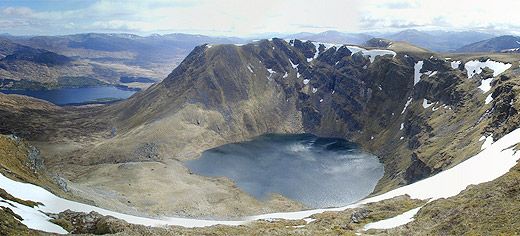
In a first for the UK, a new map detailing Scotland's wild areas is being published today by Scottish Natural Heritage (SNH).
Some of the country's wildest landscapes are already identified and protected if they fall within national parks or national scenic areas. But many other wild areas are not identified in any way.
The Scottish public view wild land as an important priority: a recent SNH study found that 91% of respondents agree that Scotland's areas of wild land are important and should be protected. Another study found wild land provides even more economic and employment benefit than agriculture and forestry combined.
These maps will help local authorities, and others involved in planning, make decisions about development and land use change, to safeguard wild land. The maps can also help the tourism industry promote Scotland's wild landscapes to visitors and walkers.
Using a method developed by the Wildland Research Institute (WRi) at the University of Leeds, a map was produced showing the relative wildness of all of Scotland's landscapes.
To view the map, see http://www.snh.gov.uk/protecting-scotlands-nature/looking-after-landscapes/landscape-policy-and-guidance/wild-land/mapping/This spring, more detailed maps identifying wild land will also be developed.
Simon Brooks, SNH Policy and Advice manager, said:
"These new maps will give valuable, detailed information to local authorities to inform decisions. Scotland is famous for its wild landscapes - these maps tell us where the wildest areas are and will help everyone when considering changes in these places. The maps don't mean changes or development can't take place in these areas, but they do give local authorities more and better information to base planning decisions on.
"Using the maps and information published today, future work will identify areas of particular high wildness value. This work will build on our earlier work to identify wild land, and will support the Scottish Government's policy of safeguarding areas of wild land character."
Dr Stephen Carver of the University of Leeds said:
"It's great to see the methodologies that we developed here at the University of Leeds and with our partners in the Wildland Research Institute being used across the whole of the country. Scotland has taken the lead here, and is the first country in Europe to produce a national wildness map at this level of detail, so it's very exciting to see these maps.
"Although we're not surprised by the broad patterns shown, as we already have a good feeling for where the wild areas of Scotland are, the key thing with these maps is the fine detail and how they were created using the latest data and mapping tools. This makes them robust and repeatable. Hopefully, England and Wales will follow suit and produce their own maps in due course."
For more information
Dr Steve Carver is available for interview. Please contact the University of Leeds Press Office on +44 (0)113 343 4031 or email pressoffice@leeds.ac.uk
Scottish Natural Heritage press & public relations officers: Vicki Mowat on 0131 316 2659 or vicki.mowat@snh.gov.uk (Tues to Fri) or Heather Kinnin on 0131 316 2606 or heather.kinnin@snh.gov.uk (Mon to Wed) Airson na meadhanan Gí idhlig cuiribh fios gu / For Gaelic media enquiries contact:Emily Edwards, SNH Inverness, 01463 725 148, emily.edwards@snh.gov.uk
Image credit: Scottish Natural Heritage
Notes
Scottish Natural Heritage is the government's adviser on all aspects of nature and landscape across Scotland. Our role is to help everyone understand, value and enjoy Scotland's nature now and in the future. For more information, visit our website at www.snh.gov.uk. SNH media is also now on Twitter at www.twitter.com/SNHMedia
The mapping methodology was based on an approach developed for the Cairngorms National Park by Dr Stephen Carver, a senior lecturer in the Department of Geography at the University of Leeds, and a team at the University's Wildland Research Institute (WRi). Dr Carver has undertaken a similar study of the Loch Lomond and The Trossachs National Park and provided technical assistance to SNH in developing the national map of wildness for Scotland.
The approach uses a Geographical Information System to map four aspects of wild land: perceived naturalness (presence of natural and semi-natural vegetation), absence of man-made features, remoteness from public roads, and ruggedness of the terrain. Each aspect can be viewed individually, or combined together to map the relative wildness of Scotland's landscapes, revealing which is the most and least wild. More details on the mapping approach can be found at www.snh.gov.uk/protecting-scotlands-nature/looking-after-landscapes/landscape-policy-and-guidance/wild-land/mapping/More details about the University of Leeds work for Scotland's National Parks can be found on their website: